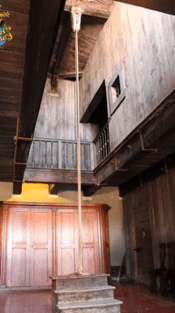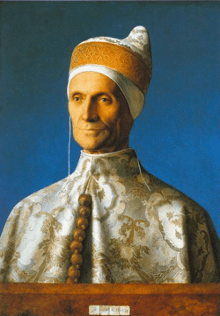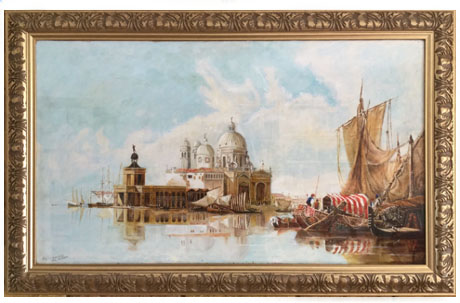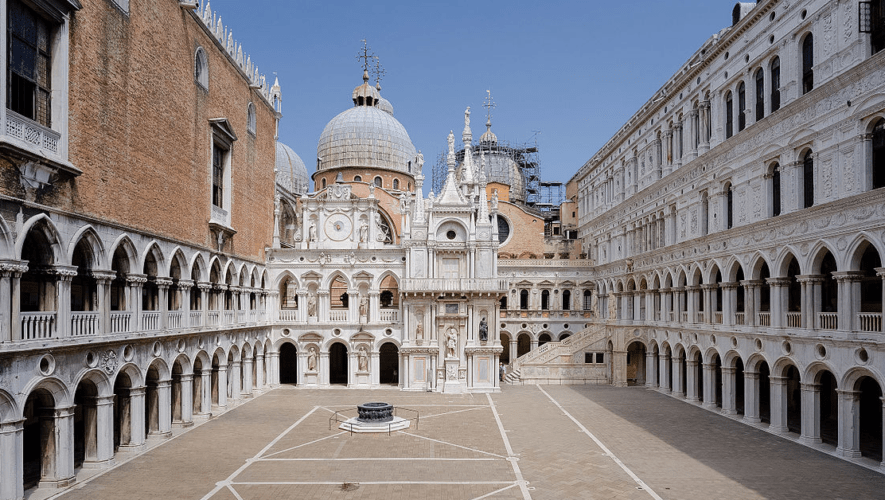The Rulers of Venice where the Reverend Claudio Monteverdi lived and worked were known as “Dogi”. In Italian this is pronounced “dodgy” The singular of this plural noun, “Doge” is also pronounced “dodgy” at least it sounds the same to Old Gnu’s mostly deaf ears. To mask some of the brutality and terror that some of these rulers displayed Old Gnu prefers to call them Doggies. This makes them sound more friendly.
But make no mistake about it, the splendid Doggie’s Palace (above) was a place of frightening power, terror and torture. Here is the main torture chamber:

The Doggies wore funny hats like this:

This is Doggy Lenardo Loredan [1502-3]. It seems he only lasted long enough to have his portrait painted. Shame! What a very nice outfit wasted.
The Doggies were elected leaders for life. They weren’t hereditary dukes. The best way to describe them is “Chief Magistrates”. Venice was not the only city to have Doggies. One other city, Genoa, also also had Doggies. From this we can conclude that Doggies liked to live by the seaside. The first recorded Venetian Doggie went by the name Ursus. From this we may surmise that the he may have been part bear. Though there is some confusion here, as he was also known as Orso, in which case he may have been part horse. Unfortunately, whatever he was, he got murdered. And his son became the Doggie. This was not true to the spirit of the Dogato [Monarch – Monarchy, Doggie – Dogato; comprenez ?] Hereditary-ness was contrary to the principles of Dogatoic – [Gnu made this word up] – Succession.
So from 737-742 there was a period of improper Dogato. In rapid succession Dominicus Abrogatis [Dominic ‘the Abolisher’, a bit like Dominic Cummings] was succeeded by Felice Cornicola [his name means ‘Happy Crow’’] and so on and so forth. At the resumption of the proper Dogato, in 742, normality finally returned and the first three in this period were all deposed, blinded and exiled. And so it went on. It was truly a dodgy Doggie carry-on.
Things were politically stable in the Reverend Claudio’s time, but if even if they weren’t he would have been quite safe and beyond the possible brutalities of the Doggies and false accusations, on which Venetian society thrived. He was known internationally. His music was not only performed in San Marco’s but elsewhere in Italy. He got commissions to write new operas from regions beyond Venice. All this made him an immeasurable asset to the Venetian Republic. The bigger miracle is that the Venetian authorities really appreciated him. There are slight parallels here with the status of the unrepentant Catholic, William Byrd, at the time of the English Reformation.
The Puritans told composers what sort of music they were to write. Byrd continued to write the most divine music in his Catholic tradition, defying the ‘law’. He willingly paid fines, the penalty for not attending the now protestant parish church. But like the Rev. Claudio, Mr. Byrd was too big a fish to consider getting rid of him. Never was a hand placed on him because he too was a ‘national treasure.’ Likewise Dimitri Shostakovich in the rule of terror by Stalin; Russian composers were told what sort of music to write. The consequences of not complying could have been grave. But despite living in fear he was not sent to Siberia or murdered like some of his friends and colleagues. He was too big a name internationally. Or indeed just like Mr. Trump, who threatened to close down Twatter because it didn’t do things his way. Funny really; some commentators say it was one of the main vehicles some say that got him into power.
So you see, this is what the Rev. C. Monteverdi, William Byrd, Dimitri Shostakovich and Twatter have in common. They all survived, nay conquered, under [potentially] tyrannical regimes. To get rid of any of these would have been shooting yourself in the foot.

But then, as we have learnt recently, things can happen that even economic, military power and tyranny cannot completely control.
In 1627 Duke Vincent II of Mantua, [where Claudio M. worked before he got the job at San Marco] died, leaving no heirs. And, as today, foreign powers waded in to beat the hell out of the Mantuans, till they got who they, the outsiders, wanted in power. The German and French troops carried more than their weapons; they brought the plague to the city of Mantua in 1629. Venetian troops, infected with the disease, retreated into northern and central Italy, spreading the infection. A second wave followed in the spring and summer of 1631. “The city of Venice was severely hit, with recorded casualties of 46,000 people out of a population of 140,000. Some historians believe the drastic loss of life, and its impact on commerce, ultimately resulted in the downfall of Venice as a major commercial and political power.” Thus saith Mr. Waki Pedia. Milan fared worse – 60,000 fatalities out of a total population of 130,000. Church Services were stopped. Not one naff, stomach churning warship song was heard for months in any church [Hurrah!]. The Rev. Claudio’s choir at San Marco’s lost 24 of its 32 singers and many instrumentalists [ Not Hurrah!].
Two things, nay four, happened after the plague: firstly Rev. Claudio survived without catching the plague. Secondly, he rebuilt the choir and instrumental group and brought the music back up to scratch at San Marco’s. Thirdly he also spent more time composing secular music, namely operas and wrote his greatest masterpiece, an opera, L’incoronazione di Poppea and set the history of opera on its course.
Fourthly the very peace loving, pillaging, god-fearing Venetians, the Doggie included, decided to build an enormous church as a thank offering to the Almighty once the plague had died out – the Church of Santa Maria della Salute at the mouth of the Grand Canal.
Comme ça:

This is Old Gnu’s forgery of a painting by J.W. Muller painted in the 1830s.
You don’t know just how pleased God was! And, it has helped the Venetian tourist industry for centuries later [but probably not at the moment].
What shall we build when the plague is over? I guess it might unfortunately be HST2. And no doubt God will be equally pleased!
Vetus Pater Gnu
Musicorum et Theologia
Turris LA
IX Mensis Iunni MMXX

